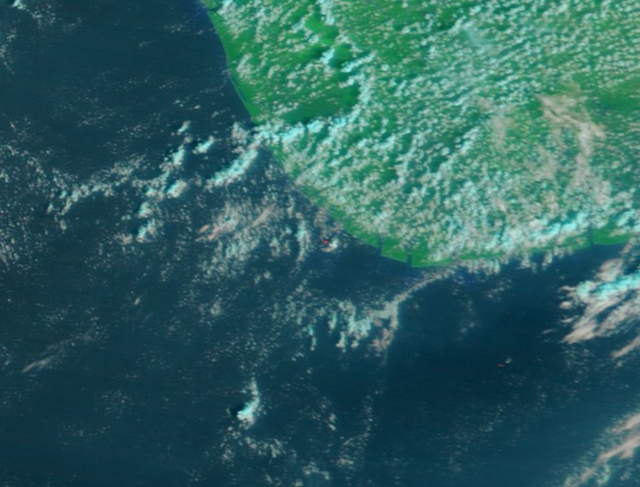Dead fish, health problems emerge as Chevron rig off Nigeria continues to burn after accident
LAGOS, Nigeria, 6 February 2012 (AP) – The burning inferno of what used to be a Chevron Corp. natural gas rig, the K.S. Endeavor, still stains the night’s sky orange more than two weeks after the rig caught fire, and no one can say when it will end as swarms of dead fish surface. The environmental damage is hitting a region whose poor still rely on the delta’s muddy waters for survival. A nearby clinic remains overrun with patients who are showing up with skin irritations and gastrointestinal problems. “The community here has no other source of water apart from the river water, which on its own isn’t even safe enough to drink, but the pollution has made the water even worse,” said Dr. Oladipo Folorunso, the only doctor in the town of Ikebiri. Folorunso attributes the illnesses to the burning rig, as rising temperatures in water can cause bacteria to thrive. A satellite image showed that the fire at a point was at least 1,340 degrees Fahrenheit (nearly 730 degrees Celsius), “hot enough to soften steel,” an independent watchdog group called SkyTruth said. The fire began Jan. 16 from a shallow-water gas well for Chevron’s Nigerian subsidiary near its North Apoi oil platform. The accident killed two foreign workers and caused tens of millions of dollars in damage. Chevron says it continues to investigate what started the fire but is not offering any estimate on how long it will burn. Nigeria’s government believes a “gas kick” — a major buildup of gas pressure from drilling — was responsible, said Levi Ajuonoma, a spokesman for the state-run Nigerian National Petroleum Corp. […] It also remains unclear when the fire will be put out. Chevron, based in San Ramon, California, has said that it would take 30 days to drill to total depth of 9,000 feet (2,740 meters) to create a relief well that would help put out the fire. […] Foreign firms have pumped oil for more than 50 years out of the delta, a region of swamps, mangroves and creeks roughly the same size as South Carolina. Many in the delta remain desperately poor, living in polluted waters without access to proper medical care, education or work. Nigerian regulators often fall back on international standards set by engineering and trade groups as a yardstick for safety measures, but the country’s institutionalized graft and mismanagement means oil companies largely answer only to themselves in safety matters.
Dead fish, health problems emerge as Chevron rig off Nigeria continues to burn after accident 
By John Amos
6 February 2012 NASA/MODIS satellite imagery taken yesterday shows that the blowout and fire at a Chevron gas well off the coast of Nigeria continues. That’s 20 days and counting. It will take weeks to drill a relief well; according to Chevron the Transocean relief rig is on site, and drilling should begin soon. Chevron “has moved food and supplies to the communities in the area to recognize the help and support that they have given the company.”

What?????